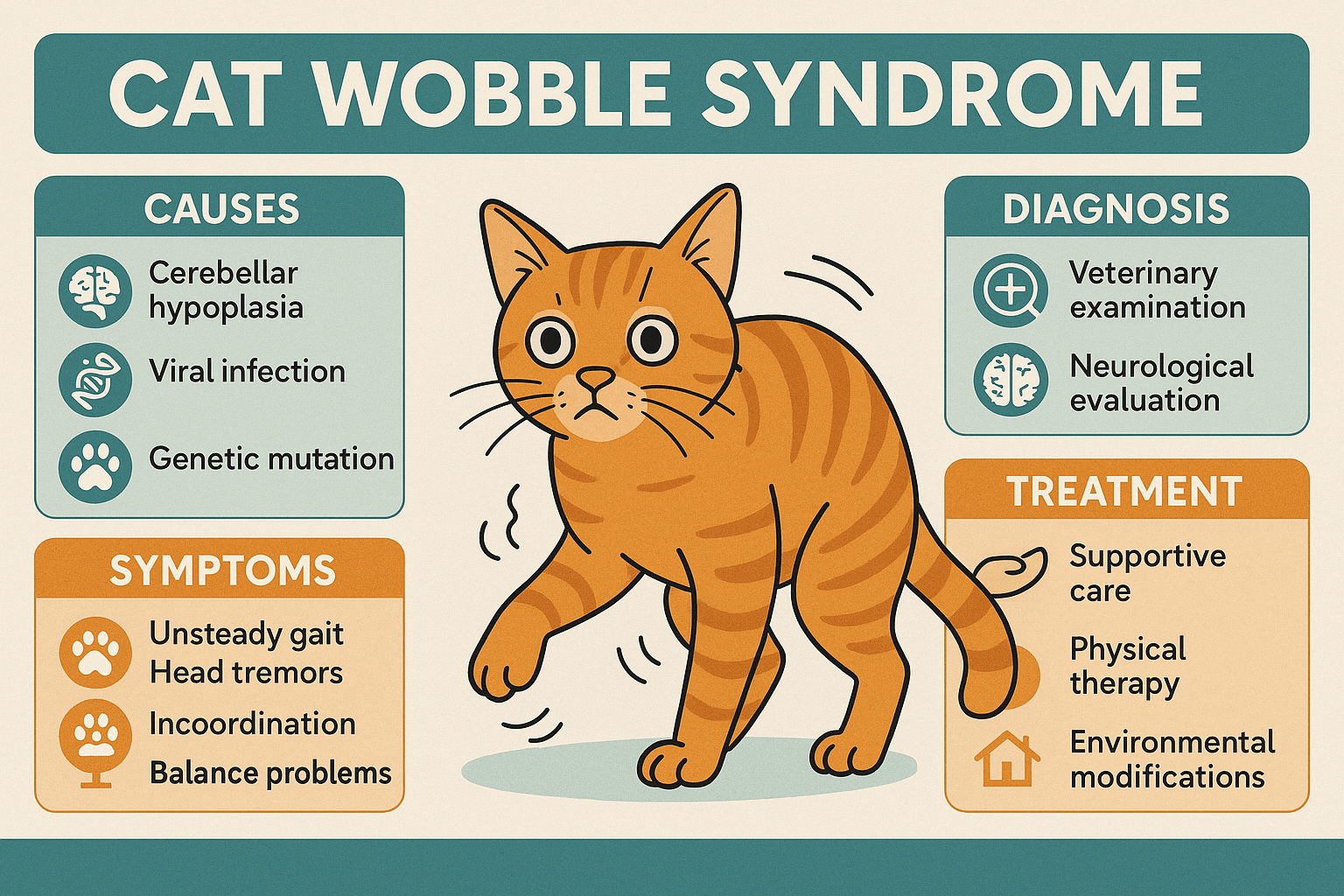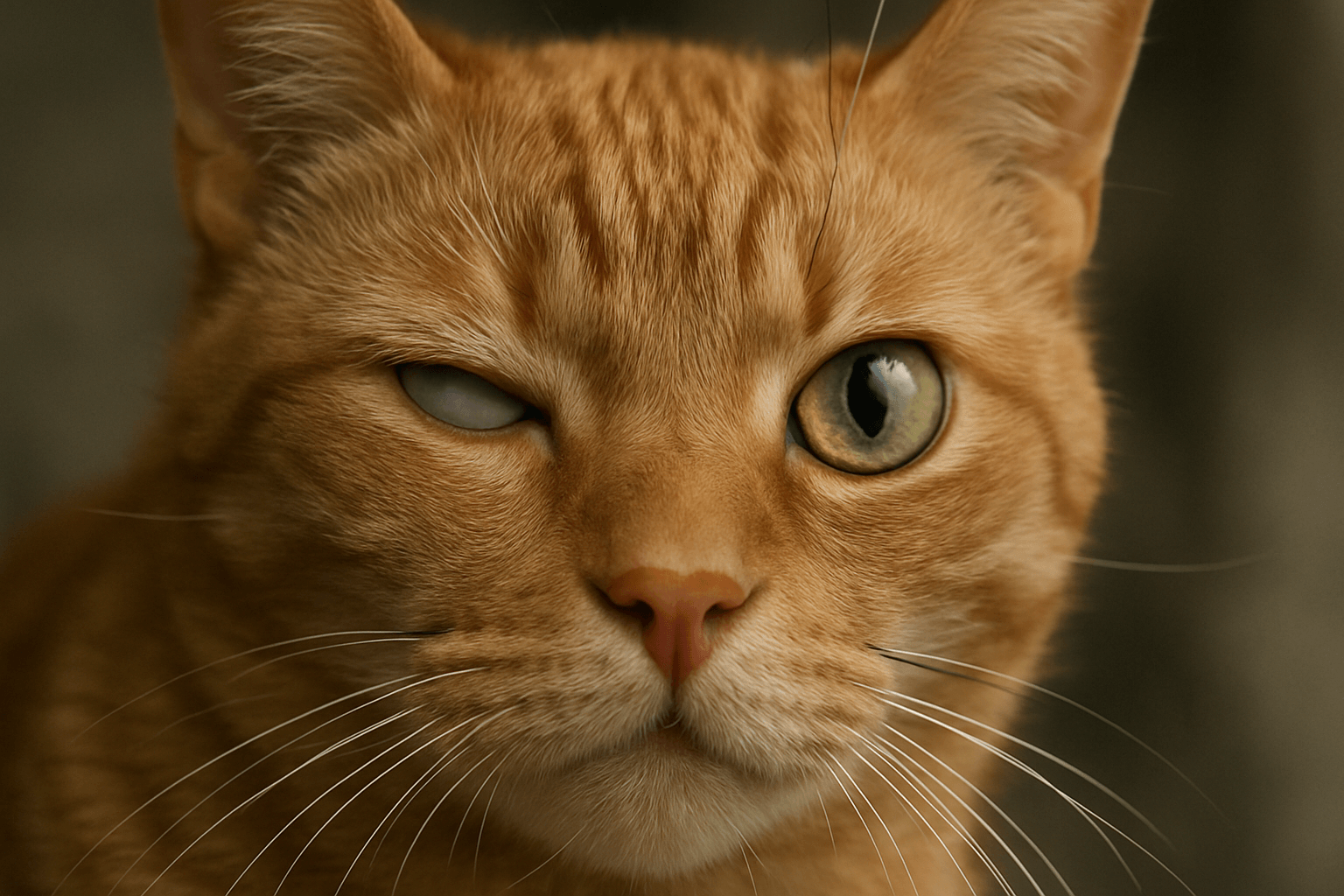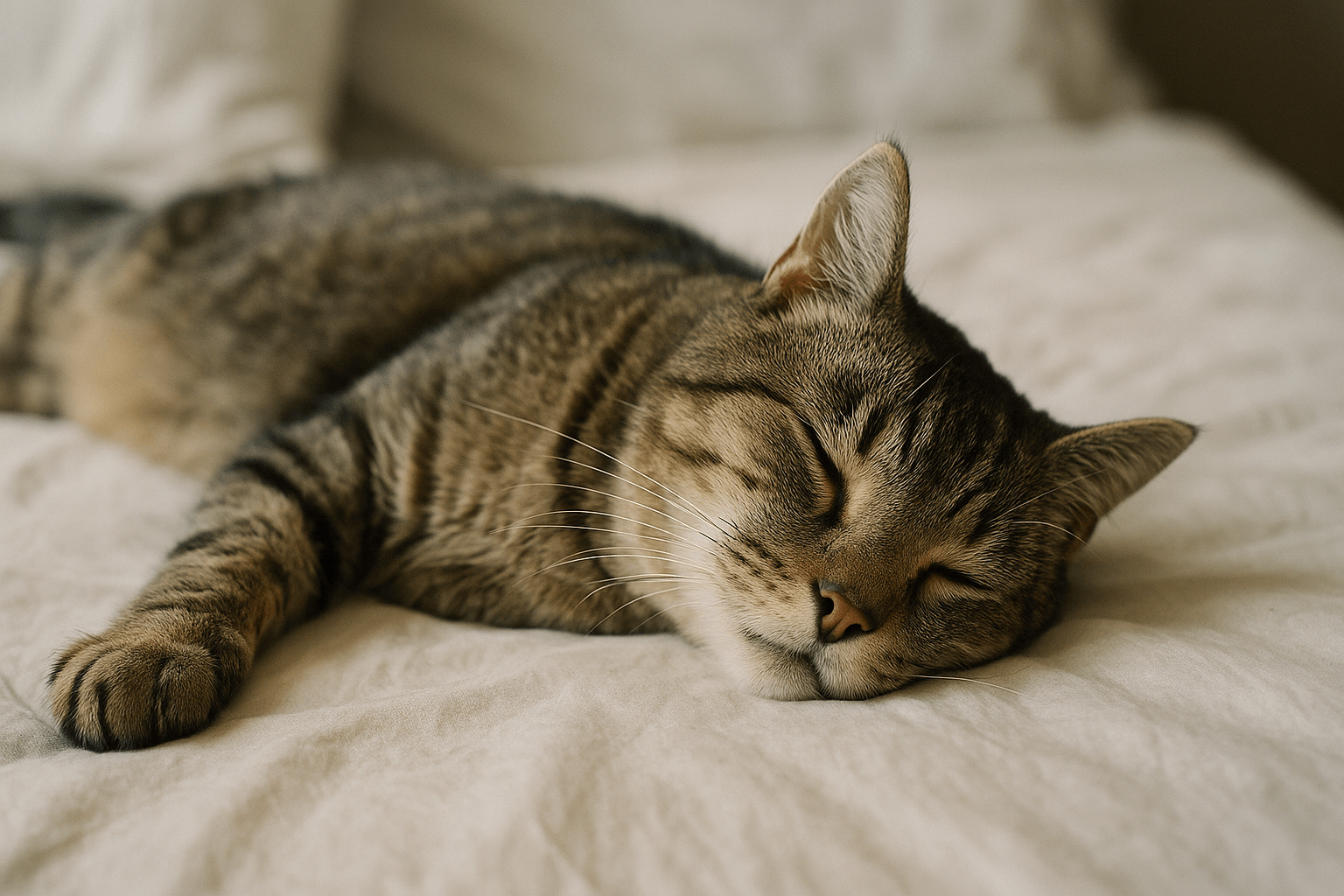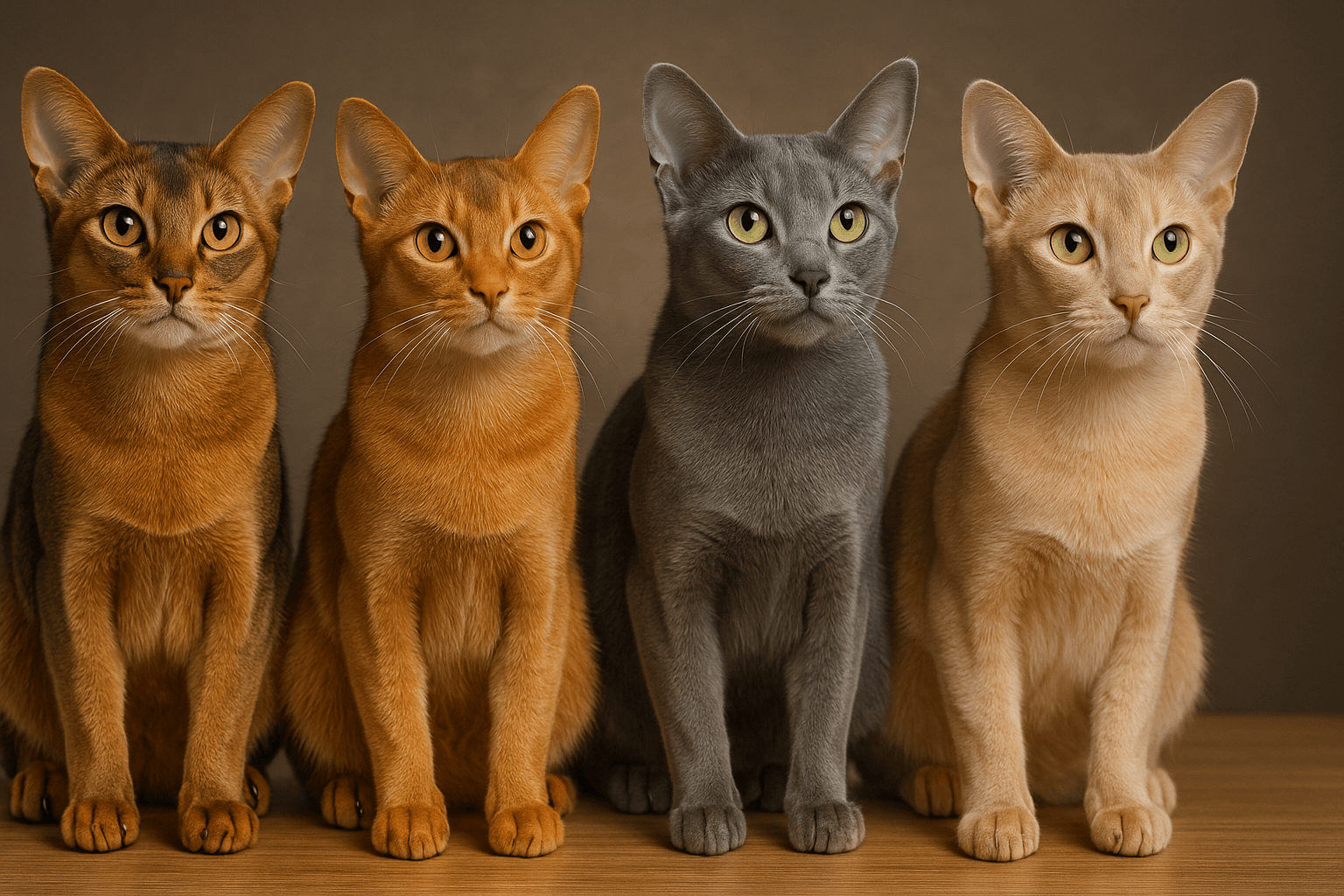Understanding Cat Wobble Syndrome: Causes, Symptoms, and Care
Cat wobble syndrome, also known as cerebellar hypoplasia, is a neurological condition that affects a cat’s balance and coordination. While it may sound concerning, this condition is not painful or life-threatening for affected cats. Instead, it often results in adorable, clumsy movements that endear these felines to their owners. Cats with wobble syndrome typically have an underdeveloped cerebellum, the part of the brain responsible for motor control, leading to their characteristic unsteady gait. In this blog post, we’ll explore everything you need to know about cat wobble syndrome, from its causes and symptoms to how you can provide the best care for your wobbly companion.
Expert Insight on Wobbly Cat Syndrome
“Wobbly Cat Syndrome is a neurological condition in cats that results from the underdevelopment or malformation of the cerebellum, which is responsible for coordinating movements, maintaining balance, and controlling fine motor skills.”
What Causes Cat Wobble Syndrome?
The exact cause of cat wobble syndrome varies, but it is often linked to developmental issues during pregnancy or early kittenhood. Understanding these causes can help cat owners better grasp the condition and its origins.
Maternal Infections:
Viral infections like feline panleukopenia (FPV) contracted by the mother during pregnancy can disrupt cerebellar development in unborn kittens.Trauma During Birth:
Physical trauma or oxygen deprivation during delivery may damage the kitten’s developing brain, leading to wobble syndrome.Genetic Factors:
Some cases are believed to result from genetic predispositions, though this is less common than environmental factors.Toxin Exposure:
Exposure to certain toxins during pregnancy or early life can interfere with cerebellar growth, causing wobble symptoms later on.Nutritional Deficiencies:
Poor maternal nutrition during pregnancy can impact fetal brain development, potentially resulting in cerebellar hypoplasia.
While the condition cannot be cured, understanding its causes helps caregivers focus on providing supportive care tailored to their cat’s unique needs.
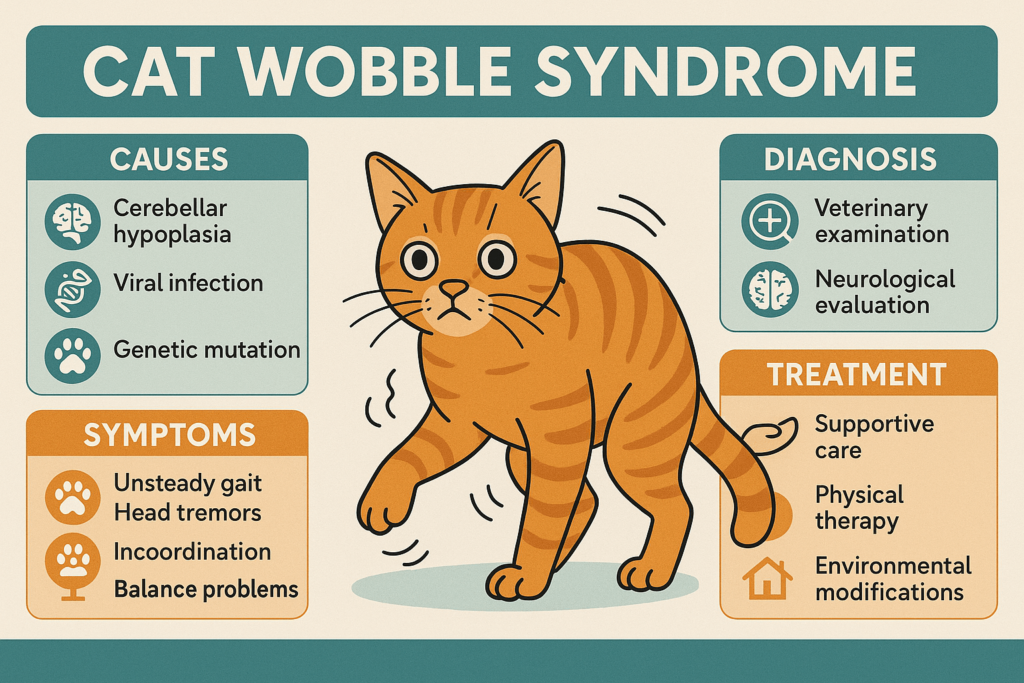
Recognizing Symptoms of Cat Wobble Syndrome
Cats with wobble syndrome exhibit distinct behaviors due to their impaired motor skills. These symptoms are usually noticeable from birth or shortly after and remain consistent throughout their lives.
Unsteady Gait:
Affected cats often walk with a wide stance and sway side-to-side, giving them their signature “wobbly” appearance.Difficulty Jumping:
They may struggle to judge distances when jumping, often falling short or overshooting their target.Head Tremors:
Intention tremors—shaking of the head when focusing on food or toys—are common in cats with cerebellar hypoplasia.Clumsy Movements:
Activities like climbing stairs or navigating tight spaces can pose challenges for wobbly cats.No Pain or Discomfort:
Despite their awkward movements, cats with wobble syndrome do not experience pain or discomfort related to their condition.
These symptoms highlight the importance of patience and adaptability when caring for a cat with wobble syndrome.
Check this guide 👉Manx Syndrome in Cats: Best 7 Expert Tips!
Check this guide 👉Aqueous Misdirection Syndrome in Cats: Best 7 Expert Tips!
Check this guide 👉Understanding Swimmer Syndrome in Cats: Best 7 Tips!
Living with a Wobbly Cat | Tips for Daily Care |
|---|---|
Provide non-slip surfaces | Use rugs or mats to prevent slipping |
Create accessible spaces | Lower shelves and easy-to-reach beds |
Monitor feeding habits | Place food and water bowls at ground level |
Supervise outdoor time | Keep them safe in enclosed gardens |
Celebrate their uniqueness | Embrace their quirks and playful nature |
How to Support Your Wobbly Cat’s Well-Being
Caring for a cat with wobble syndrome requires thoughtful adjustments to ensure they live a happy and fulfilling life. Here are some strategies to support your furry friend effectively.
Adapt Their Environment:
Remove hazards like sharp edges or high furniture that could pose risks during their unpredictable movements.Provide Soft Landing Spots:
Place cushions or padded mats around areas where your cat likes to jump or rest to minimize injury risks.Encourage Gentle Play:
Engage your cat in low-impact activities using toys that don’t require precise movements, such as soft balls or feather wands.Regular Veterinary Check-Ups:
Schedule routine vet visits to monitor overall health and address any secondary issues that may arise.Be Patient and Observant:
Understand that your cat will move at their own pace; observe their behavior to identify what works best for them.
By implementing these strategies, you can create a nurturing environment that allows your wobbly cat to thrive.
Misconceptions About Cat Wobble Syndrome
Despite growing awareness, several misconceptions surround cat wobble syndrome. Dispelling these myths helps foster greater understanding and acceptance of affected cats.
It Is Not Contagious:
Wobble syndrome is not caused by viruses or bacteria and cannot spread to other animals or humans.Affected Cats Can Live Long Lives:
With proper care, cats with wobble syndrome can enjoy normal lifespans without significant health complications.They Are Not Mentally Impaired:
The condition only affects motor skills—not intelligence—so wobbly cats are just as clever as their peers.Adoption Is Worthwhile:
Many shelters house cats with wobble syndrome who make loving, affectionate pets despite their unique challenges.There Is No Cure, But Life Is Still Full:
While there’s no treatment for the condition itself, supportive care ensures a rich and joyful life for these special cats.
Clarifying these misconceptions encourages more people to open their hearts and homes to cats with wobble syndrome.
Tips for Keeping Your Wobbly Cat Safe Indoors
Creating a safe indoor space is essential for cats with wobble syndrome, as their mobility challenges can put them at risk. Follow these tips to ensure their environment is secure and comfortable.
Block Off Hazardous Areas:
Prevent access to balconies, staircases, or pools where accidents might occur.Use Baby Gates:
Install gates to section off rooms or areas that may be difficult for your cat to navigate safely.Secure Heavy Objects:
Anchor bookshelves, TVs, and other heavy items to prevent tipping if your cat bumps into them.Provide Low Perches:
Offer sturdy, low perches for resting and observing their surroundings without needing to jump.Supervise Interactions with Other Pets:
Ensure other animals in the household are gentle and won’t accidentally harm your wobbly cat during play.
A safe indoor setup allows your wobbly cat to explore and thrive without unnecessary risks.
Fun Ways to Bond with Your Wobbly Cat
Bonding with a wobbly cat is just as fun—and sometimes even more rewarding—as bonding with any other feline. Here are some creative ways to strengthen your connection.
Interactive Toys:
Use wand toys or laser pointers to engage your cat in interactive play sessions.Treat Puzzles:
Introduce treat-dispensing puzzles designed for cats to stimulate their minds and reward their efforts.Gentle Massage:
Give your cat a soothing massage to relax their muscles and deepen your bond.Cozy Nap Time:
Spend quiet moments together napping or simply lounging side-by-side.Capture Memories:
Take photos or videos of your cat’s playful antics to celebrate their one-of-a-kind charm.
These activities not only entertain your cat but also reinforce the special bond you share.
How to Advocate for Special-Needs Cats
Special-needs cats, including those with wobble syndrome, deserve love, care, and advocacy. Here’s how you can help raise awareness and support these amazing animals.
Educate Others:
Share information about cat wobble syndrome to dispel myths and encourage adoption.Volunteer at Shelters:
Offer your time to assist shelters caring for special-needs cats, whether through fostering or volunteering.Donate Supplies:
Contribute food, bedding, or toys specifically suited for cats with mobility challenges.Promote Adoption Events:
Help organize or promote events focused on finding homes for special-needs cats.Join Online Communities:
Connect with groups dedicated to supporting wobbly cats and their caregivers for advice and camaraderie.
By advocating for special-needs cats, you can help change perceptions and inspire others to welcome these extraordinary companions into their lives.
Frequently Asked Questions About Cat Wobble Syndrome
Is wobble syndrome painful for cats?
No, the condition does not cause pain or discomfort, though it affects their coordination and mobility.
Can cats with wobble syndrome go outside?
It’s safer to keep them indoors or in secure enclosures to protect them from potential hazards.
Will my cat’s symptoms improve over time?
Symptoms typically remain stable throughout their life, but most cats adapt well to their limitations.
Do all cats with cerebellar hypoplasia wobble the same way?
The severity and specific symptoms vary depending on the extent of cerebellar underdevelopment.
How can I adopt a cat with wobble syndrome?
Contact local shelters or rescue organizations specializing in special-needs cats to find your perfect match.
Embracing the Joy of Caring for a Wobbly Cat
Cats with wobble syndrome remind us that perfection isn’t what makes a pet lovable—it’s their unique personalities and unwavering spirit that truly matter. By understanding their needs and making small adjustments to accommodate their quirks, you can provide a safe, happy home for your wobbly companion. Whether they’re clumsily chasing toys or snuggling up for a nap, these extraordinary cats bring boundless joy and unconditional love into our lives. With patience, compassion, and a little creativity, you’ll discover that living with a wobbly cat is not just rewarding—it’s an unforgettable journey filled with laughter, warmth, and endless cuddles.
Why Is My Cats Second Eyelid Showing? Best 7 Expert Tips! Understand causes, health signs, and how to respond when your cat’s third eyelid becomes visible.
How Do I Know If My Cat Died Peacefully? Best 7 Expert Tips! Discover the quiet signs of a peaceful feline passing and find comfort in their final moments.
Cat Allergy Eyes: Best 7 Expert Tips! Discover why your eyes react to cats and learn proven strategies for relief—without giving up your feline friend.
Why Do Abyssinian Cat Colors Matter? Best 7 Expert Tips! Discover the genetics, rare hues, and care secrets behind Abyssinian coat colors for a healthier, happier cat.

